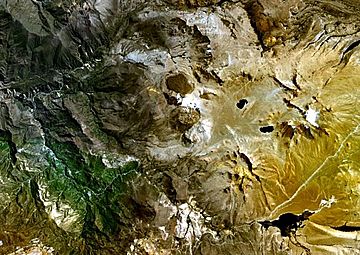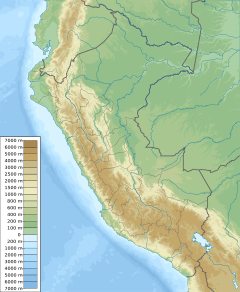Ticsani facts for kids
Quick facts for kids Ticsani |
|
|---|---|

The Ticsani lava dome complex (center)
|
|
| Highest point | |
| Elevation | 5,408 m (17,743 ft) |
| Geography | |
| Location | Moquegua Region |
| Parent range | Andes |
| Geology | |
| Mountain type | Lava domes |
| Last eruption | 1800 ± 200 years |
Ticsani is a volcano located in Peru. It is found northwest of the city of Moquegua. Ticsani is actually made up of two main parts: "Old Ticsani" and "Modern Ticsani". Together, they form a complex volcano.
"Old Ticsani" was a much larger volcano in the past. It experienced a huge collapse, sending a massive amount of rock and debris down the Rio Tambo valley. Today, only a curved ridge remains from this ancient volcano. "Modern Ticsani" is newer. It consists of three lava domes that formed more recently. Two big eruptions happened from Modern Ticsani. These created deposits known as "Grey Ticsani" and "Brown Ticsani". The last eruption occurred after the year 1600. Ticsani is still active today. It has hot springs and fumaroles (gas vents). The Peruvian government has been watching the volcano since 2015.
Contents
Where is Ticsani?
Ticsani is located in the Ichuna District of Peru. It is about 59 kilometers (37 miles) northwest of Moquegua. The Putina River flows to the northwest of the volcano. The Carumas River flows to its southwest. This area is quite remote, meaning it's far from cities. This has made it hard for scientists to explore the volcano. There are paved roads nearby, especially the Ilo-Desaguadero highway. This road passes within 12 kilometers (7.5 miles) of the Ticsani domes.
Volcanoes in South America are found along the western coast. Ticsani is part of a group called the Central Volcanic Zone. In southern Peru, this zone includes many volcanoes. Some of these are Solimana, Coropuna, Ampato, Sabancaya, Chachani, El Misti, Ubinas, and Huaynaputina. Most of Peru's volcanoes were active in the last few million years. They mainly produced a type of rock called andesite.
What Ticsani Looks Like
Ticsani has three main lava domes. These domes were formed by volcanic activity in the last ice age and more recently. Two of these domes are found inside or near craters. The dome farthest to the southeast is 1.6 kilometers (1 mile) wide and 250 meters (820 feet) tall. The middle dome is the largest. It is 2 kilometers (1.2 miles) wide and at least 250 meters (820 feet) tall. The northwestern dome is 1.95 by 1.5 kilometers (1.2 by 0.9 miles) in size.
Fast-moving flows of hot rock and gas, called pyroclastic flows, have filled valleys on the eastern side. These flows were created when the lava domes grew and sometimes collapsed. The older volcano, "Old Ticsani," is now a 3-kilometer (1.9-mile) long curved ridge. This ridge is northeast of the northernmost dome. It opens towards the west. This old volcano covers an area of 65 square kilometers (25 square miles). It is made of ignimbrite (rock from ash flows), lava flows, and debris from a huge collapse. Ticsani's highest point is 5,408 meters (17,743 feet) above sea level. The location of the lava domes was shaped by cracks in the Earth's crust called faults.
How Ticsani Formed
Off the coast of South America, a large piece of the Earth's crust, called the Nazca Plate, is sliding under the South America Plate. This process is called subduction. It happens at a speed of about 10.3 centimeters (4 inches) per year. This sliding causes the Andes mountains to grow. It also creates volcanoes in the region.
Ticsani is often grouped with its nearby volcanoes, Huaynaputina and Ubinas. This is because they share similar underground features and rock types. Huaynaputina had a very large eruption in 1600. Ubinas is currently the most active volcano in southern Peru. Scientists think these volcanoes might share a magma chamber (a pool of molten rock) deep underground. This chamber could be 20 to 30 kilometers (12 to 19 miles) deep.
The ground beneath these volcanoes includes very old rocks. These are covered by younger sedimentary and volcanic rocks. Volcanic activity continued for millions of years, forming different types of volcanic rocks.
What Ticsani is Made Of
The "Old Ticsani" volcano erupted andesite rock. The "Modern Ticsani" lava domes erupted dacite rock. Both of these are types of volcanic rock rich in potassium. Inside these rocks, you can find small crystals. These crystals include amphibole, biotite, feldspar, plagioclase, pyroxene, and quartz.
Ticsani's Eruption History
Ticsani has been active for a very long time, both in the Pleistocene (Ice Age) and the Holocene (current geological period). First, the "Old Ticsani" volcano grew. This volcano later collapsed, creating a huge landslide deposit in the Rio Tambo valley. This was one of the largest collapses in southern Peru during the Ice Age.
Later, the "Modern Ticsani" started to form. It produced lava flows and then the three lava domes. The southeastern dome is the oldest, and the northwestern one is the youngest. Ticsani had two or three big explosive eruptions. These eruptions sent out volcanic ash, rock fragments, lava bombs, and pumice (lightweight volcanic rock).
The first major eruption, called the "Grey Ticsani" Pumice eruption, happened about 10,600 years ago. It was the most powerful explosive eruption at Ticsani. Its deposits created large desert areas east of the volcano. Another eruption formed the "Grey Ticsani" Ash. The last big eruption, called "Brown Ticsani," happened after the Huaynaputina eruption in 1600. This eruption produced a smaller amount of ash and rock. It happened before the youngest lava dome formed. This stage also created lava flows that filled valleys. There are no records of Ticsani erupting in recent human history.
Today, hot springs are found in the valleys west of Ticsani. Two fumaroles (gas vents) have been seen at its top. Some well-known hot springs are at Chuchumbaya, Putina Arriba, and Secolaque. The Putina River hot springs are very important in Peru. In 2005, scientists noticed earthquake activity under Ticsani. This caused worry among local people. A series of earthquakes, called a seismic swarm, happened between 2014 and 2017. Ticsani is known for special "hybrid" earthquakes. These are felt at seismic stations of other volcanoes. Scientists have installed equipment to watch Ticsani's activity.
Dangers from Ticsani
About 5,000 people live within 15 kilometers (9.3 miles) of Ticsani. They could be in danger if the volcano erupts again. The main dangers include ash fall, lahars (mudflows), pyroclastic flows, and the collapse of lava domes.
Large explosive eruptions like "Grey Ticsani" and "Brown Ticsani" sent material mainly to the north-northeast and southeast. If a similar eruption happens again, towns like Calacoa, Cuchumbaya, and San Cristóbal could be covered by ash. Ashfall could also affect major roads, water reservoirs, mines, and airports.
Pyroclastic flows are very fast-moving flows of hot rock fragments and gases. At Ticsani, these flows have traveled at least 5 kilometers (3.1 miles) from the volcano. It is unlikely that the "Old Ticsani" volcano will collapse again. The "Modern Ticsani" is considered stable. However, parts of the old volcano could still break off. This could create lahars in the river valleys. Volcanic gases might collect in valleys, which could be dangerous. Lava flows are not expected to travel very far, so they are a smaller threat.
Ticsani is classified as a "High Risk Volcano." Since 2015, equipment has been set up to monitor the hot springs around the volcano. Devices are also in place to detect changes in the volcano's shape. The Peruvian Southern Volcanological Observatory has been publishing monthly reports on Ticsani since 2014. These reports include information on earthquake activity and sulfur dioxide gas emissions.
See also
 In Spanish: Ticsani para niños
In Spanish: Ticsani para niños


